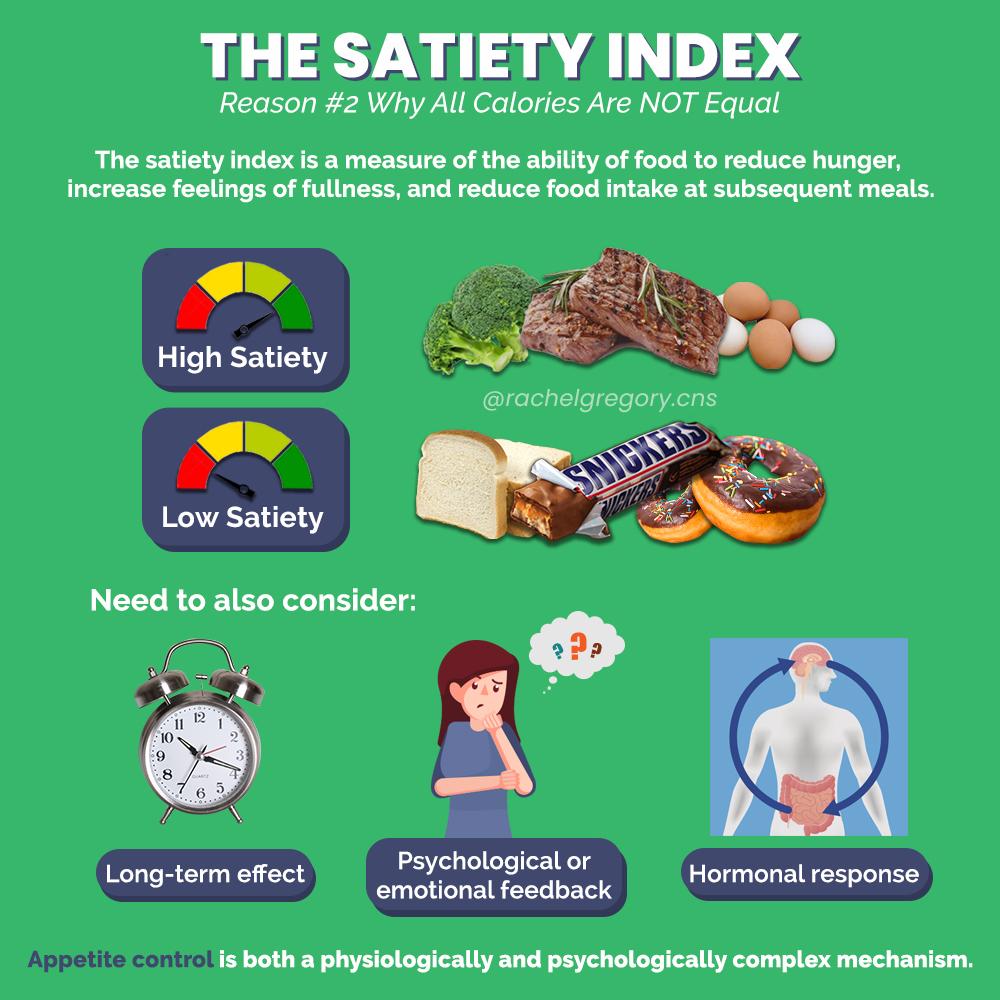
The Satiety Index: All Calories Are NOT Equal
Feb 27, 2020The satiety index is a measure of the ability of food to reduce hunger, increase feelings of fullness, and reduce food intake at subsequent meals.
This is important, especially if you have a goal of losing body fat.
Controlling appetite and hunger is the #1 step in any successful weight loss protocol. If we’re hungry all day long, how can we expect to follow through with sustaining a diet?
What Is the Satiety Index?
In the ‘traditional’ sense, the satiety index is an actual scale that was developed in 1995 that tested 38 different foods and ranked them according to their ability to satisfy hunger over a 2-hour period (i.e., short-term satiety). [*]
Based on this scale, the results showed that foods higher in protein, fiber, and volume tended to be the most filling.
For example, we know from Reason #1 Why All Calories Are NOT Equal, studies show that protein is by far the most filling macronutrient. [*,*] We also know that we have stretch-receptors in our stomach and intestine that send a signal of fullness to our brain when high-volume/high-fiber foods are consumed. [*]
I think we can all agree that it's pretty easy to crush 500 calories or more of ice cream (and go back for more within 20 minutes), while you'd have to put some serious effort into mindlessly eating 500 calories of eggs or broccoli.
The satiety index is another clear example of why all calories are NOT created equal.
But, I think we can (and should) dig a bit deeper into satiety, past what the traditional satiety scale measures.
Satiety Scale
When studying the satiating power of different foods, we have to consider the magnitude and duration of its effects. Changes in appetite ratings after consumption of a ‘test' food should also be observed after chronic consumption of the food (i.e., after several days or weeks) not just a short period of time (i.e., 2-hours).
For example, volume can be expected to exert satiety effects in the short term, whereas nutrient and energy contents play a critical role in the longer term. [*]
The traditional satiety index doesn’t necessarily take into account some of the other factors involved in how certain foods affect appetite and hunger. Particularly as they relate to different psychological and hormonal responses.
Satiety Cascade Model
However, there is something known as the satiety-cascade model. This model proposes that even before food arrives in your stomach, cognitive and sensory signals generated by the sight and smell of food, and by the orosensory experience of food in the mouth, will influence not only how much is eaten at that particular meal (satiation) but also in the period after the meal (satiety).
These early satiety signals will integrate with post-ingestive and post-absorptive signals (fancy words for after food is ingested and absorbed) to determine satiety. [*]

Adapted from Blundell et al.
Appetite control is both a physiologically and psychologically complex mechanism.
The psychological response to food involves many different factors such as reward, emotion, habit, and stress.
I think we all know that hunger is not the only thing affecting how much, what type, and when we eat. The psychological response to food absolutely plays a role in how satisfying or satiating that food feels to us, on an emotional level.
Check out the blog on emotional eating for more info and tips on this subject: …And then I ate my feelings.
So now that you understand how different foods can affect satiety, both through the satiety index and the satiety-cascade model… are you still thinking all calories are created equal?
Still not convinced? Let's dive a little deeper!
Check out Reason #3 Why All Calories Are NOT Created Equal! And check out our women's fitness program to get personalized help with your nutrition!

References
- https://www.ncbi.nlm.nih.gov/pubmed/7498104
- https://www.ncbi.nlm.nih.gov/pubmed/18469287
- https://www.ncbi.nlm.nih.gov/pubmed/15466943
- https://www.sciencedaily.com/releases/2019/11/191114115918.htm
- https://academic.oup.com/jn/article/142/6/1149S/4689069
- https://www.sciencedirect.com/science/article/pii/S0924224414002386#fig1
Ready to join a group of strong, confident, badass women?
Don't miss a beat!
Get my weekly tips, exercises, recipes, and more fun stuff to your inbox every Friday.
Your information is safe.


